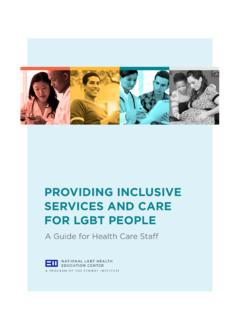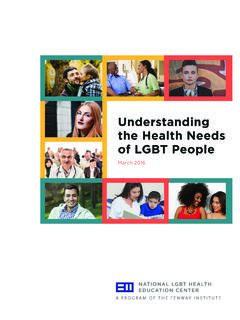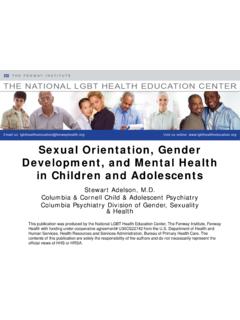Transcription of Glossary of LGBT Terms for Health Care Teams
1 Glossary of LGBT Terms for Health Care Teams As a provider in a Health center or other Health care organization, becoming familiar with Terms used by lesbian, gay, bisexual, transgender (LGBT) communities can help you provide these patients with the highest quality care. In this Glossary , you will find some of the Terms most relevant to the Health care of LGBT people. When reading this Glossary , here are a few things to keep in mind: 1) Definitions vary across communities; not all of your LGBT patients will agree with all of these definitions; 2) There are many Terms not included on this list; we tried to keep the list as concise and relevant to Health care providers as possible; 3) Terms and definitions change frequently; we will try to update this list to keep up with changing language. If you have a suggestion, please email us at Agender (adj.) Describes a person who identifies as having no gender. Ally (noun) A person who supports and stands up for the rights of LGBT people.
2 Aromantic (adj.) An orientation that describes a person who experiences little or no romantic attraction to others and/or a lack of interest in forming romantic relationships. Asexual (adj.) Describes a person who experiences little or no sexual attraction to others. Asexuality is not the same as celibacy. Assigned sex at birth (noun) The sex (male or female) assigned to a child at birth, most often based on the child's external anatomy. Also referred to as birth sex, natal sex, biological sex, or sex. Bigender (adj.) Describes a person whose gender identity is a combination of two genders. Binding (verb) The process of tightly wrapping one's chest in order to minimize the appearance of having breasts. This is achieved through use of constrictive materials such as cloth strips, elastic or non-elastic bandages, or specially designed undergarments. Biphobia (noun) The fear of, discrimination against, or hatred of bisexual people or those who are perceived as such.
3 Bisexual (adj.) A sexual orientation that describes a person who is emotionally and sexually attracted to people of their own gender and people of other genders. Bottom surgery (noun) Colloquial way of describing gender affirming genital surgery. Page 1 of 7. Cisgender (adj.) A person whose gender identity and assigned sex at birth correspond ( , a person who is not transgender). Coming out (verb) The process by which one accepts and/or comes to identify one's own sexual orientation or gender identity (to come out to oneself). Also the process by which one shares one's sexual orientation or gender identity with others (to come out to friends, etc.). Cross-sex hormone therapy (noun) The administration of hormones for those who wish to match their physical secondary sex characteristics to their gender identity. Disorders of Sex Development (DSD) (noun) Group of rare conditions where the reproductive organs and genitals do not develop as expected.
4 Some DSDs include Klinefelter Syndrome and Androgen Sensitivity Syndrome. Sometimes called differences of sex development. Some people prefer to use the term intersex. Drag (verb) The performance of one or multiple genders theatrically. Those who perform are called Drag Kings and Drag Queens. Gay (adj.) A sexual orientation that describes a person who is emotionally and sexually attracted to people of their own gender. It can be used regardless of gender identity, but is more commonly used to describe men. Gender affirming surgery (GAS) (noun) Surgeries used to modify one's body to be more congruent with one's gender identity. Also referred to as sex reassignment surgery (SRS) or gender confirming surgery (GCS). Gender binary (noun) The idea that there are only two genders, male and female, and that a person must strictly fit into one category or the other. Gender dysphoria (noun) Distress experienced by some individuals whose gender identity does not correspond with their assigned sex at birth.
5 Manifests itself as clinically significant distress or impairment in social, occupational, or other important areas of functioning. The Diagnostic and Statistical Manual of Mental Disorders (DSM-5) includes gender dysphoria as a diagnosis. Gender expression (noun) The way a person acts, dresses, speaks, and behaves ( , feminine, masculine, androgynous). Gender expression does not necessarily correspond to assigned sex at birth or gender identity. Gender fluid (adj.) Describes a person whose gender identity is not fixed. A person who is gender fluid may always feel like a mix of the two traditional genders, but may feel more one gender some days, and another gender other days. Page 2 of 7. Gender identity (noun) A person's internal sense of being a man/male, woman/female, both, neither, or another gender. Gender non-conforming (adj.) Describes a gender expression that differs from a given society's norms for males and females. Gender role (noun) A set of societal norms dictating what types of behaviors are generally considered acceptable, appropriate or desirable for a person based on their actual or perceived sex.
6 Genderqueer (adj.) Describes a person whose gender identity falls outside the traditional gender binary. Other Terms for people whose gender identity falls outside the traditional gender binary include gender variant, gender expansive, etc. Sometimes written as two words (gender queer). Heteronormativity (noun) The assumption that everyone is heterosexual, and that heterosexuality is superior to all other sexualities. Heterosexual (straight) (adj.) A sexual orientation that describes women who are emotionally and sexually attracted to men, and men who are emotionally and sexually attracted to women. Homophobia (noun) The fear of, discrimination against, or hatred of lesbian or gay people or those who are perceived as such. Intersectionality (noun) The idea that identities are influenced and shaped by race, class, ethnicity, sexuality/sexual orientation, gender/gender identity, physical disability, national origin, etc., as well as by the interconnection of all of those characteristics.
7 Intersex (noun) Group of rare conditions where the reproductive organs and genitals do not develop as expected. Some prefer to use the term disorders (or differences) of sex development. Intersex is also used as an identity term by some community members and advocacy groups. Lesbian (adj., noun) A sexual orientation that describes a woman who is emotionally and sexually attracted to other women. Page 3 of 7. Men who have sex with men/Women who have sex with women (MSM/WSW) (noun) . Categories that are often used in research and public Health settings to collectively describe those who engage in same-sex sexual behavior, regardless of their sexual orientation. However, people rarely use the Terms MSM or WSW to describe themselves. Minority stress (noun) Chronic stress faced by members of stigmatized minority groups. Minority stress is caused by external, objective events and conditions, expectations of such events, the internalization of societal attitudes, and/or concealment of one's sexual orientation.
8 Outing (verb) Involuntary or unwanted disclosure of another person's sexual orientation or gender identity. Pangender (adj.) Describes a person whose gender identity is comprised of many genders. Pansexual (adj.) A sexual orientation that describes a person who is emotionally and sexually attracted to people regardless of gender. Polyamorous (adj.) Describes a person who has or is open to having more than one romantic or sexual relationship at a time, with the knowledge and consent of all their partners. Sometimes abbreviated as poly. QPOC (noun) An acronym that stands for Queer Person of Color or Queer People of Color. Queer (adj.) An umbrella term used by some to describe people who think of their sexual orientation or gender identity as outside of societal norms. Some people view the term queer as more fluid and inclusive than traditional categories for sexual orientation and gender identity. Due to its history as a derogatory term, the term queer is not embraced or used by all members of the LGBT community.
9 Questioning (adj.) Describes an individual who is unsure about or is exploring their own sexual orientation and/or gender identity. Same gender loving (SGL) (adj.) A term used as an alternative to the Terms gay and lesbian. SGL is more commonly but not exclusively used by members of the African American/Black community. Page 4 of 7. Same-sex attraction (SSA) (noun) A term that is used to describe the experience of a person who is emotionally and/or sexually attracted to people of the same gender. Individuals using this term may not feel comfortable using the language of sexual orientation ( , gay, lesbian, bisexual) for personal reasons. Use of this term is not indicative of a person's sexual behavior. It is used most commonly in religious communities. Sexual orientation (noun) How a person characterizes their emotional and sexual attraction to others. Social stigma (noun) Negative stereotypes and social status of a person or group based on perceived characteristics that separate that person or group from other members of a society.
10 Structural stigma (noun) Societal conditions, policies, and institutional practices that restrict the opportunities, resources, and well-being of certain groups of people. Top surgery (noun) Colloquial way of describing gender affirming surgery on the chest. Trans man/transgender man/female-to-male (FTM) (noun) A transgender person whose gender identity is male may use these Terms to describe themselves. Some will just use the term man. Trans woman/transgender woman/male-to-female (MTF) (noun) A transgender person whose gender identity is female may use these Terms to describe themselves. Some will just use the term woman. Transfeminine (adj.) Describes people who were assigned male at birth, but identify with femininity to a greater extent than with masculinity. Transgender (adj.) Describes a person whose gender identity and assigned sex at birth do not correspond. Also used as an umbrella term to include gender identities outside of male and female.










